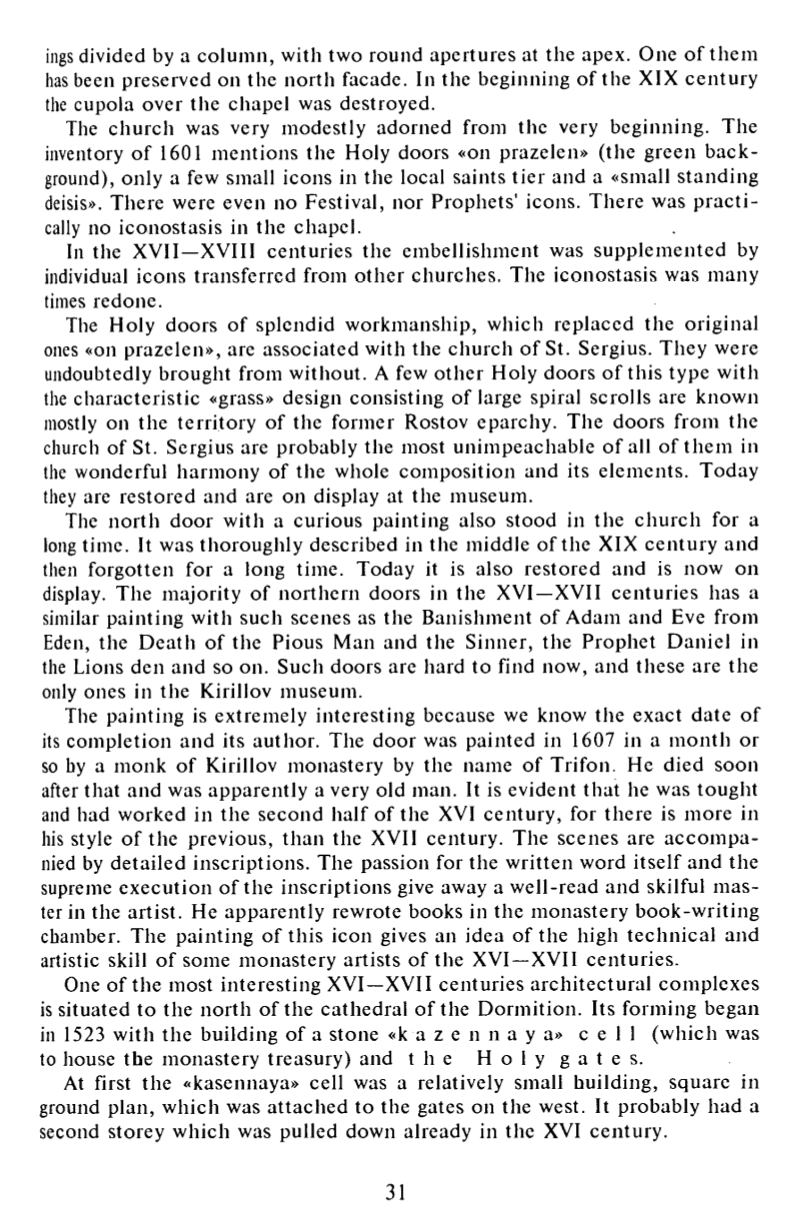

ings divided by a column, with two round apertures at the apex. One o f them
has been preserved on the north facade. In the beginning of the XIX cen tury
the cupola over the chapel was destroyed.
The church was very modestly adorned from the very beginning. The
inventory o f 1601 mentions the Holy doors
«011
prazelen» (the green back
ground), only a few small icons in the local saints tier and a «small standing
deisis». There were even
110
Festival, nor Prophets' icons. There was p r ac ti
cally
110
iconostasis in the chapel.
In the XVII—XVIII centuries the embellishment was supplemen ted by
individual icons transferred from o ther churches. The iconostasis was many
times redone.
The Holy doors of splendid workmanship, which replaced the original
ones
«011
prazelen», are associated with the church o f St. Sergius. They were
undoubtedly brought from without. A few o ther Holy doors o f this type with
the characteristic «grass» design consisting of large spiral scrolls are known
mostly
011
the territory of the former Rostov eparchy. The doors from the
church of St. Sergius are probably the most unimpeachable o f all of them in
the wonderful harmony of the whole composition and its elements. Today
they are restored and are
011
display at the museum.
The no rth door with a curious painting also stood in the chu rch for a
long time. It was thoroughly described in the middle of the XIX cen tury and
then forgotten for a long time. Today it is also restored and is now on
display. The majority of northern doors in the XVI—XVII centuries has a
similar painting with such scenes as the Banishment of Adam and Eve from
Eden, the Death of the Pious Man and the Sinner, the Prophet Daniel in
the Lions den and so on. Such doors are hard to find now, and these are the
only ones in the Kirillov museum.
The painting is extremely interesting because we know the exact date of
its completion and its author. The door was painted in 1607 in a mon th or
so hy a monk o f Kirillov monastery by the name of Trifon. He died soon
after that and was apparently a very old man. It is evident that he was tought
and had worked in the second half o f the XVI century, for there is more in
his style o f the previous, than the XVII century. The scenes are a c com p a
nied by detailed inscriptions. The passion for the written word itself and the
supreme execution of the inscriptions give away a well-read and skilful mas
ter in the artist. He apparently rewrote books in the monastery book-writing
chamber. The painting of this icon gives an idea of the high techn ica l and
artistic skill o f some monastery artists of the XVI—XVII centuries.
One of the most interesting XVI—XVII centuries architectural complexes
is situated to the north of the cathedral o f the Dormition. Its forming began
in 1523 with the building of a stone «к а z e
11
11
а у a» c e l l (which was
to house the monastery treasury) and t h e H o l y g a t e s .
At first the «kasennaya» cell was a relatively small building, square in
ground plan, which was a ttached to the gates
011
the west. It probably had a
second storey which was pulled down already in the XVI century.
31















